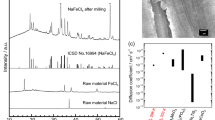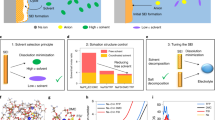Abstract
Sodium metal chloride batteries possessing many merits, such as high energy density and long cycle life, are usually operated above 300 °C. Such high operating temperature may accelerate corrosion and aging, increase operating complexity, require an extra thermal management system, and limit their widespread applications. Lowering the working temperature may alleviate these issues and broaden their usage. Herein, a sodium copper chloride battery running at 175 °C is designed with the room temperature ionic liquid, 1-ethyl-3-methylimidazolium bis(trifluoromethylsulfonyl)imide dissolved with sodium trifluoromethanesulfonate, to replace sodium chloride saturated sodium tetrachloroaluminate as the catholyte. The cathode delivers the high specific capacity of 141.4 mAh g−1 and the high energy density of 374.7 Wh kg−1. In addition, the capacity retention reaches 92.1% after 50 cycles with an average coulombic efficiency as high as 99.6%. The examination of the cathode and solid electrolyte collected after 50 cycles shows that the degradation mechanism of the battery is attributed to (1) the accumulation of a large amount of non-conductive copper chloride in the three dimensional network structure of the copper foam and (2) the loss of β″-alumina in the solid electrolyte during the charge/discharge process.








Similar content being viewed by others
References
Coetzer J (1986) A new high energy density battery system. J Power Sources 18:377–380. https://doi.org/10.1016/0378-7753(86)80093-3
Sudworth JL (1994) Zebra batteries. J Power Sources 51:105–114. https://doi.org/10.1016/0378-7753(94)01967-3
Cleaver B, Cleaver DJ, Littlewood L, Demott DS (1995) Reversible and irreversible heat effects in ZEBRA cell. J Appl Electrochem 25:1128–1132. https://doi.org/10.1007/BF00242540
Prakash J, Redey L, Vissers DR (2000) Dynamic performance measurements of Na/NiCl2 cells for electric vehicle applications. J Power Sources 87:195–200. https://doi.org/10.1016/S0378-7753(99)00473-5
Steinbock L, Dustmann CH (2001) Investigation of the inner structures of ZEBRA cells with a microtomograph. J Electrochem Soc 148:A132–A136. https://doi.org/10.1149/1.1341240
Dustmann CH (2004) Advances in ZEBRA batteries. J Power Sources 127:85–92. https://doi.org/10.1016/j.jpowsour.2003.09.039
Brett DJL, Aguiar P, Brandon NP, Bull RN, Galloway RC, Hayes GW, Lillie K, Mellors C, Smith C, Tilley AR (2006) Concept and system design for a ZEBRA battery-intermediate temperature soild oxide fuel cell hybrid vehicle. J Power Sources 157:782–798. https://doi.org/10.1016/j.jpowsour.2005.12.054
Palomares V, Serras P, Villaluenga I, Hueso KB, Carretero-González J, Rojo T (2012) Na-ion batteries, recent advances and present challenges to become low cost energy storage systems. Energy Environ Sci 5:5884–5901. https://doi.org/10.1039/C2EE02781J
Ao X, Wen Z, Hu Y, Wu T, Wu X, He Q (2017) Enhanced cycle performance of a Na/NiCl2 battery based on Ni particles encapsulated with Ni3S2 layer. J Power Sources 340:411–418. https://doi.org/10.1016/j.jpowsour.2016.11.091
Ao X, Wen Z, Wu X, Wu T, Wu M (2017) Self-repairing function of Ni3S2 layer on Ni particles in the Na/NiCl2 cells with the addition of sulfur in the catholyte. ACS Appl Mater Interfaces 9:21234–21242. https://doi.org/10.1021/acsami.7b03873
Dunn B, Kamath H, Tarascon JM (2011) Electrical energy storage for the grid: a battery of choices. Science 334:928–935. https://doi.org/10.1126/science.1212741
Wu Y, Zeng R, Nan J, Shu D, Qiu Y, Chou SL (2017) Quinone electrode materials for rechargeable lithium/sodium ion batteries. Adv Energy Mater 7:1700278. https://doi.org/10.1002/aenm.201700278
Chen X, Wu Y, Huang Z, Yang X, Li W, Yu LC, Zeng R, Luo Y, Chou SL (2016) C10H4O2S2/graphene composite as a cathode material for sodium-ion batteries. J Mater Chem A 4:18409–18415. https://doi.org/10.1039/C6TA05853A
Yabuuchi N, Kubota K, Dahbi M, Komaba S (2014) Research development on sodium-ion batteries. Chem Rev 114:11636–11682. https://doi.org/10.1021/cr500192f
Lu X, Coffey G, Meinhardt K et al (2010) High power planar sodium-nickel chloride battery. ECS Trans 28:7–13. https://doi.org/10.1149/1.3492326
Chang HJ, Canfield NL, Jung K, Sprenkle VL, Li G (2017) Advanced Na-NiCl2 battery using nickel-coated graphite with core–shell microarchitecture. ACS Appl Mater Interfaces 9:11609–11614. https://doi.org/10.1021/acsami.7b00271
Chang HJ, Lu X, Bonnett JF, Canfield NL, Son S, Park YC, Jung K, Sprenkle VL, Li G (2018) “Ni-Less” cathodes for high energy density, intermediate temperature Na–NiCl2 batteries. Adv Mater Interfaces 5:1701592. https://doi.org/10.1002/admi.201701592
Li G, Lu X, Coyle CA, Kim JY, Lemmon JP, Sprenkle VL, Yang Z (2012) Novel ternary molten salt electrolytes for intermediate-temperature sodium/nickel chloride batteries. J Power Sources 220:193–198. https://doi.org/10.1016/j.jpowsour.2012.07.089
Lu X, Li G, Kim JY, Lemmon JP, Sprenkle VL, Yang Z (2013) A novel low-cost sodium-zinc chloride battery. Energy Environ Sci 6:1837–1843. https://doi.org/10.1039/c3ee24244g
Lu X, Chang HJ, Bonnett JF, Canfield NL, Jung K, Sprenkle VL, Li G (2018) An intermediate-temperature high-performance Na-ZnCl2 battery. ACS Omega 3:15702–15708. https://doi.org/10.1021/acsomega.8b02112
Li G, Lu X, Kim JY, Viswanathan VV, Meinhardt KD, Engelhard MH, Sprenkle VL (2015) An advanced Na-FeCl2 ZEBRA battery for stationary energy storage application. Adv Energy Mater 5:1–7. https://doi.org/10.1002/aenm.201500357
Che H, Chen S, Xie Y, Wang H, Amine K, Liao XZ, Ma ZF (2017) Electrolyte design strategies and research progress for room-temperature sodium-ion batteries. Energy Environ Sci 10:1075–1101. https://doi.org/10.1039/C7EE00524E
Yang LP, Liu XM, Zhang YW, Yang H, Shen XD (2014) Advanced intermediate temperature sodium copper chloride battery. J Power Sources 272:987–990. https://doi.org/10.1016/j.jpowsour.2014.09.014
Park SH, Moore CW, Kohl PA, Winnick J (2001) A study of copper as a cathode material for ambient temperature sodium ion battery. J Electrochem Soc 148:A1346. https://doi.org/10.1149/1.1413479
Ratnakumar BV, Stefano SD, Halpert G (1990) Electrochemistry of metal chloride cathodes in sodium batteries. J Electrochem Soc 137:2991–2997. https://doi.org/10.1149/1.2086147
Chen PY, Sun IW (1999) Electrochemical study of copper in a basic 1-ethyl-3-methylimidazolium tetrafluoroborate room temperature molten salt. Electrochim Acta 45:441–450. https://doi.org/10.1016/S0013-4686(99)00275-3
Pye S, Winnick J, Kohl PA (1997) Iron, copper, and nickel behavior in buffered, neutral aluminum chloride: 1-Methyl-3-ethylimidazolium chloride molten salt. J Electrochem Soc 144:1933. https://doi.org/10.1149/1.1837724
Monti D, Jónsson E, Palacín MR, Johansson P (2014) Ionic liquid based electrolytes for sodium-ion batteries: Na+ solvation and ionic conductivity. J Power Sources 245:630–636. https://doi.org/10.1016/j.jpowsour.2013.06.153
He F, Wang J, Deng D (2011) Effect of Bi2O3 on structure and wetting studies of Bi2O3-ZnO-B2O3 glasses. J Alloys Compd 509:6332–6336. https://doi.org/10.1016/j.jallcom.2011.03.087
Li G, Lu X, Kim JY, Lemmon JP, Sprenkle VL (2014) Improved cycling behavior of ZEBRA battery operated at intermediate temperature of 175°C. J Power Sources 249:414–417. https://doi.org/10.1016/j.jpowsour.2013.10.110
Wu F, Zhu N, Bai Y, Liu L, Zhou H, Wu C (2016) Highly safe ionic liquid electrolytes for sodium-ion battery: wide electrochemical window and good thermal stability. ACS Appl Mater Interfaces 8:21383–21384. https://doi.org/10.1021/acsami.6b07054
Balo L, Shalu GH, Kumar Singh V, Kumar Singh R (2017) Flexible gel polymer electrolyte based on ionic liquid EMIMTFSI for rechargeable battery application. Electrochim Acta 230:126–131. https://doi.org/10.1016/j.electacta.2017.01.177
Lu X, Li G, Kim JY, Lemmon JP, Sprenkle VL, Yang Z (2012) The effects of temperature on the electrochemical performance of sodium–nickel chloride batteries. J Power Sources 215:288–295. https://doi.org/10.1016/j.jpowsour.2012.05.020
Wu T, Zhang S, Ao X, Wu X, Yang J, Wen Z (2017) Enhanced stability performance of nickel nanowire with 3D conducting network for planar sodium-nickel chloride batteries. J Power Sources 360:345–352. https://doi.org/10.1016/j.jpowsour.2017.06.015
Prakash J, Redey L, Vissers DR (1999) Morphological considerations of the nickel chloride electrodes for ZEBRA batteries. J Power Sources 84:63–69. https://doi.org/10.1016/s0378-7753(99)00300-6
Kim M, Ahn CW, Hahn BD, Jung K, Park YC, Cho NU, Lee H, Choi JH (2017) Effects of Ni particle morphology on cell performance of Na/NiCl2 battery. Met Mater Int 23:1234–1240. https://doi.org/10.1007/s12540-017-7062-5
Li G, Lu X, Kim JY, Lemmon JP, Sprenkle VL (2013) Cell degradation of a Na-NiCl2 (ZEBRA) battery. J Mater Chem A 1:14935–14942. https://doi.org/10.1039/c3ta13644b
Bones RJ, Teagle DA, Brooker SD, Cullen FL (1989) Development of a Ni, NiCl2 positive electrode for a liquid sodium (ZEBRA) battery cell. J Electrochem Soc 30:1274–1277. https://doi.org/10.1002/chin.198937021
Hosseinifar M, Petric A (2012) High temperature versus low temperature zebra (Na/NiCl2) cell performance. J Power Sources 206:402–408. https://doi.org/10.1016/j.jpowsour.2012.01.125
Pekarsky A, Nicholson PS (1980) The relative stability of spray-frozen/freeze-dried β″-Al2O3 powders. Mater Res Bull 15:1517–1524. https://doi.org/10.1016/0025-5408(80)90111-7
Shan SJ, Yang LP, Liu XM, Wei XL, Yang H, Shen XD (2013) Preparation and characterization of TiO2 doped and MgO stabilized Na–β″-Al2O3, electrolyte via a citrate sol–gel method. J Alloys Compd 563:176–179. https://doi.org/10.1016/j.jallcom.2013.02.092
Wang J, Jiang XP, Wei XL, Yang H, Shen XD (2010) Synthesis of Na-β″Al2O3 electrolytes by microwave sintering precursors derived from the sol–gel method. J Alloys Compd 497:295–299. https://doi.org/10.1016/j.jallcom.2010.03.038
Wei X, Cao Y, Lu L, Yang H, Shen X (2011) Synthesis and characterization of titanium doped sodium beta″-alumina. J Alloys Compd 509:6222–6226. https://doi.org/10.1016/j.jallcom.2011.03.006
Funding
This work was supported by the National Natural Science Foundation of China (21573109, 21206069), the Priority Academic Program Development of Jiangsu Higher Education Institutions (PAPD), and Postgraduate Research & Practice Innovation Program of Jiangsu Province (SJCX17−0295).
Author information
Authors and Affiliations
Corresponding author
Additional information
Publisher’s note
Springer Nature remains neutral with regard to jurisdictional claims in published maps and institutional affiliations.
Rights and permissions
About this article
Cite this article
Niu, C., Zhang, Y., Ma, S. et al. An intermediate temperature sodium copper chloride battery using ionic liquid electrolyte and its degradation mechanism. Ionics 25, 4189–4196 (2019). https://doi.org/10.1007/s11581-019-03003-7
Received:
Revised:
Accepted:
Published:
Issue Date:
DOI: https://doi.org/10.1007/s11581-019-03003-7




